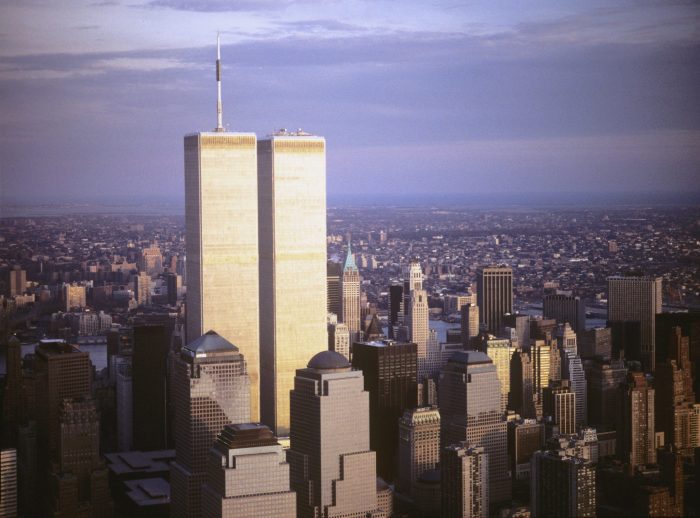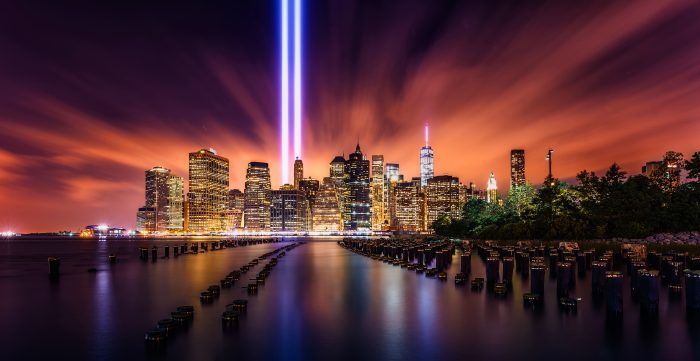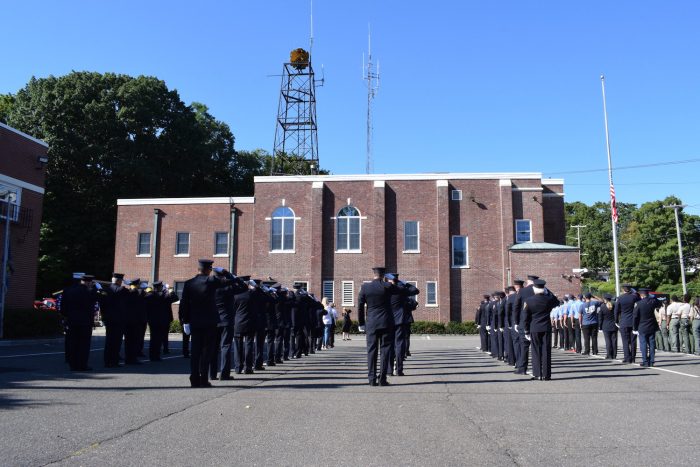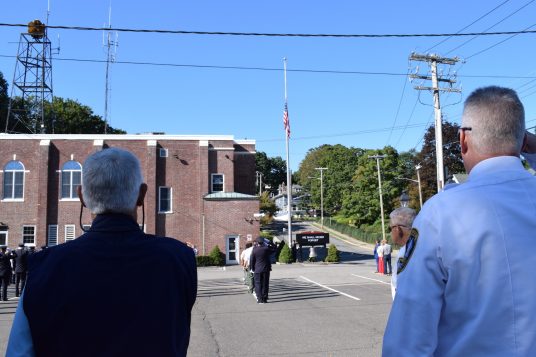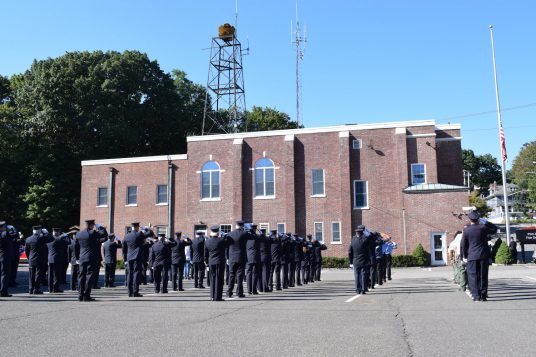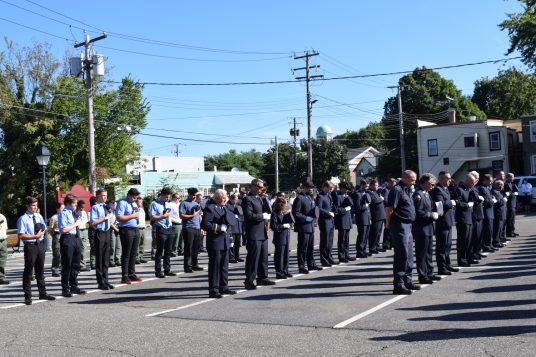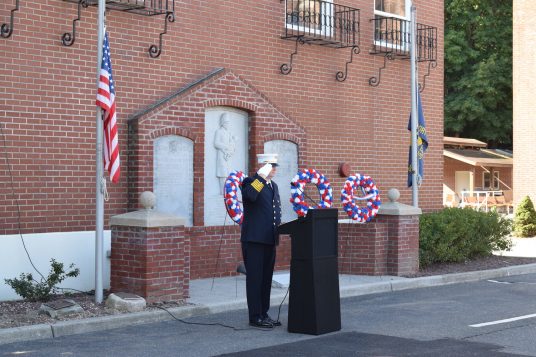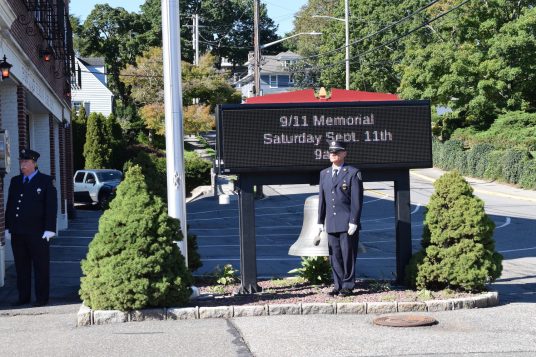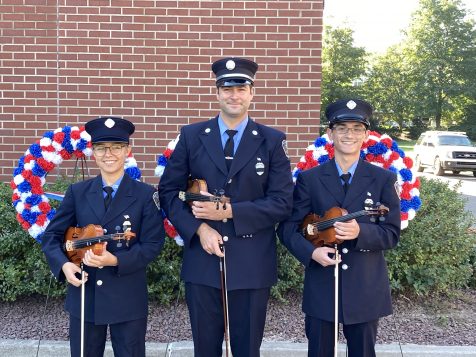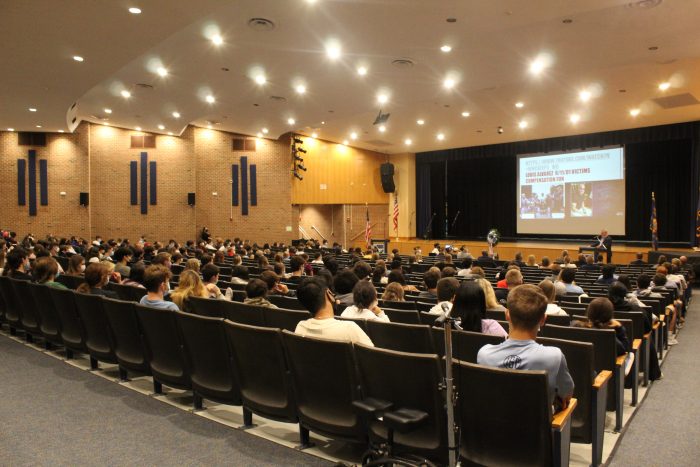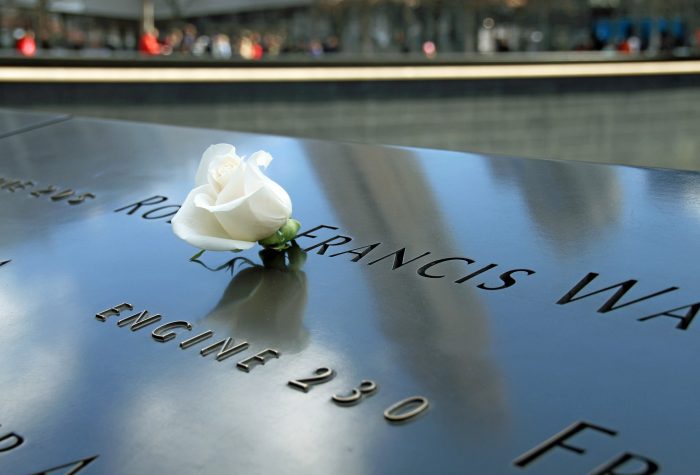Note to listeners, this episode contains graphic depictions of events on September 11th, 2001, and one offensive word.
9/11
SBU’s Sean Clouston discusses ongoing health struggles of WTC first responders
By Daniel Dunaief
Sean Clouston takes some time to reflect each year around this time.

A professor in the Department of Family, Population and Preventive Medicine in the Program in Public Health at Stony Brook University, Clouston studies the long term implications of the exposure and experiences of first responders after the attacks on the World Trade Center.
Clouston, who published research this summer that chronicled the higher rates of dementia among first responders in the years after the attack, spoke exclusively with the Times Beacon Record Newspapers about the work he does and the interactions he’s had with people who were in harm’s way in the days and weeks after the terrorist attacks.
Each September 11th is a “quiet day,” Clouston said, as he takes time to remember those lost and reflect on those who are continuing to deal with the health consequences of being there.
Clouston recalls thinking about how the attacks shaped the way he thought about what he should be doing with his life.
In the work he’s done in monitoring the role of long-duration exposures at the World Trade Center on neurological health of responders to the events following the Sept. 11 attacks, Clouston has interacted with survivors, spouses, and families, receiving regular updates.
“It’s a pretty big part of my everyday social network,” Clouston said.
 He’s heard numerous stories from a day in which the comfortable, clear air provided an incongruous backdrop for the mass murders. He has heard about people who were blown out of the buiding amid a combustible blast and about how difficult it is to put out a cesium fire.
He’s heard numerous stories from a day in which the comfortable, clear air provided an incongruous backdrop for the mass murders. He has heard about people who were blown out of the buiding amid a combustible blast and about how difficult it is to put out a cesium fire.
“There were definitelly so many different stories that speak to me,” Clouston said.
As someone who studies the outcomes of severe or early life challenges, Clouston is aware of how the traumatic events of that day reoccur for so many people, as they reexperience the moments that sometimes haunt their dreams and that can continue to affect them physically and cognitively.
People generally consider post traumatic stress as a “fairly short condition” where someone has it “immediately after an event and it kind of goes away,” Clouston said.
For first responders, however, “that’s not true. They are dealing with it for years or decades after the traumatic event.”
Indeed, first responders not only feel the effects of the physical and emotional trauma, but the experience affects their body chemistry and “changes how their immune system reacts.”
Researchers can see how it “wears away at the body over the years and over the decades,’ Clouston added.
The study of post traumatic stress allows him to focus on and understand the link between the mind and the body.
How can people help?
Clouston suggested that people who want to help first responders need to start by recognizing the specific challenges each person may be facing.
“What you do depends a lot on who the person is and what they remember and what they’re struggling with,” said Clouston.
Sept. 11th each year can be a hard time, as people confront painful memories.
People can help others by “being available to listen,” he suggested. Try to understand “why it affects them and how.”
Therapists can help, as can doctor-prescribed medications.
First responders may feel angry, which people don’t always anticipate feeling.
In his research, Clouston focuses less on day-to-day changes and more on how their exposure and experience affects them in the longer term.
First responders can become physically weaker and slower, as they are less able to lift weights.
Cognitively, the effect of the experience has also been significant.
Earlier this year, Clouston published a paper in which he found an “enormous difference” between people with minimal exposure to dust and other particulates at the World Trade Center site compared to those who were more heavily exposed, he said.
“The incidence of dementia is building on prior work showing that the longer you were on site, the more likely responders were to have slowed down cognitive function in general,” he added.
Future questions
Clouston and his colleagues are hoping to understand what disease is affecting first responders. They are unsure whether it’s a form of dementia related to other conditions or whether it’s unique to this group and this exposure.
They are hoping to explore whether people who were on site have anything in their blood that is a measure of exposure, such as chemicals or metals.
First responders don’t all need care now, but one of the goals of the research is to make sure scientists and doctors are “on top of what is really happening” as they prepare to provide any necessary help in future years.
People develop diseases when three things occur: a noxious or toxic element or viral particle exists, they are exposed to it, and people are vulnerable to its effects.
Researchers are working to understand the level of exposure and different levels of vulnerability.
Clouston also highlighted the connection between the immune system and tau proteins, which can trigger dementia in Alzheimer’s and which can spread throughout the brain.
Researchers have been exploring how some immune systems might spread these proteins, while other immune systems trigger a slower spread and, potentially, fewer and less severe symptoms.
In theory, scientists could learn from the immune system that causes a slower spread, although “we’re years away from doing anything like that,” he said.
Alternatiely, researchers and pharmaceutical companies are working on ways to remove these proteins.
“You can fight fires in two ways,” he said.
Stony Brook has been considering “those ideas. To get there, we have to first understand excatly where are we and what is the problem,” he said. “That’s where we really are for the next couple of years.”
As for his interaction with first responders, Clouston has been inspired by the way the first responder community has rallied around people who are struggling with physical and cognitive challenges.
He recalled a firefighter who was struggling with age-related conditions.
“His fellow firefighters came together and built in some lifts and ramps to help him and his spouse get around the house and use the bathroom,” he said. “Moments like that are really touching.”
Editorial: Remembering 9/11 in the year 2024
Written by a member of Gen Z
When this editorial appears in our newspapers, it will be one day after the 23rd anniversary of 9/11. A day of which our young adults have no memory.
Members of Gen Z — those in their late teens and early twenties, mostly — were not alive for the terrorist attacks on the Twin Towers, the Pentagon and those on Flight 93, which killed nearly 3,000 people in total, and continue to claim the lives of countless more as a result of 9/11-related illnesses.
Not long after that solemn day, officials started to use the phrase “Never Forget,” as a sort of chant and message of solidarity, used in speeches, at memorials and in everyday life. Just one glance at Instagram or Facebook will show streams of different variations of that phrase, written over pictures, graphics and even just written out.
Many say 9/11 was our modern-day Pearl Harbor, but let’s face it: Who’s left that remembers Pearl Harbor? At least in a way that strikes a personal chord, worth keeping in ongoing conversation.
So, when every student who just graduated college has no recollection of a day in which we have been implored to “Never Forget,” what do we do to rectify that?
Perhaps, make 9/11 a national holiday. The conversation has been in the air for quite a while, but the compromise seemed to be regarding it as the National Day of Service and Remembrance.
Maybe, teach about how those tragic events unfolded in schools. Yes, it is already taught, but perhaps in more detail.
We’ve all heard the stories of horror from our family members who were in the City on that day. Whether our families lost loved ones that day or simply remember the pit in their stomachs as they watched the second plane hit on television, the testimonies are out there.
The answers are not known to this dilemma. Who knows how many members of Gen Z feel personally connected to the day enough to go to a memorial service or watch the names being read on television. In all honesty, who knows for how many more decades the names will be read on television.
All we can hope for is that no matter how many years go by, and how the iterations of national 9/11 celebrations change, as a people we keep 9/11 sacred. Yes, different people have different interactions with 9/11, but together we can all ensure that this day does not fade into the pages of our history shelves, if we don’t want it to.
D. None of the Above: Remembering when Americans were pulling for, and with, each other
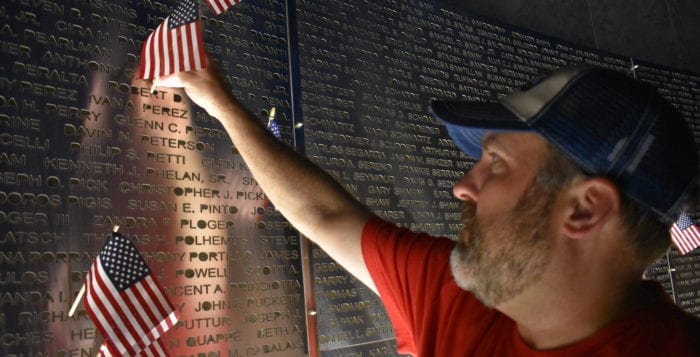
By Daniel Dunaief

September 11th is not just another day.
The country, and the world, stood still for hours, horrified and stunned by the mass murder committed by terrorists in Manhattan, Washington DC and in a field in Western Pennsylvania.
We can focus on the bravery of the first responders that day, on the remarkable effort by the passengers aboard Flight 93 to retake the plane, the loss of 2,977 people, and the passage of time since that horrible day.
We can also consider the incredible generosity and sensitivity of the country in the days, weeks and months afterwards. I know that didn’t apply to everyone and I remember how taxi drivers from mostly Muslim countries put bumper stickers on their cars indicating they were proud Americans. I also recall the unfair and horrific questioning of people who looked different or who might have originally come from Saudi Arabia or any neighboring countries.
Still, in the wake of a day that also lives in infamy, people gave of themselves and their time.
My family, which included our then three-month old daughter and my wife, walked to an upper east side fire station that lost several members when the World Trade Center collapsed.
There, we saw other people in our community who were bringing toys, pies, gifts and money to the department. The members of the fire station, whom we thanked, forced appreciative smiles on their faces and, more often than not, comforted many community members who choked out heartfelt words of thanks to the station’s survivors.
Outside the station, a car from one of those killed that day was barely visible under an enormous collection of flowers.
Prior to 9/11, I had spent considerable time writing about banks and financial services companies. I had a particular and lasting connection with several members of the boutique firm Keefe, Bruyette & Woods.
KBW provided research and investment banking services for a range of banks. In the months after the attack and the loss of lives, banks made sure to include KBW on investment banking deals, trying to help the survivors and the firm stay in business.
On Long Island, a range of companies donated construction materials to create lasting memorials to the people lost on that day, while offering families a place to go to reflect on the people they were fortunate enough to know.
The frenetic city that never sleeps entered a grieving cycle in which people implicitly knew the rules. A collection of cars passing by with their lights on behind a hearse required people always in a hurry to make way.
Despite the need to do things yesterday, to get somewhere faster than everyone else and to beat people’s own records in traveling from one place to another, people stood by, slowed down and made supportive eye contact with those who were putting up pictures of lost loved ones.
As we drove along the roads around New York City, we saw the efficient removal of debris from the World Trade Center site, with twisted metal and concrete sitting on passing flat bed trucks. Cars made room on highways for these huge trucks and turned on their lights in support and sympathy.
In a more insular way, many of us checked on our friends and family, setting aside ongoing familial disagreements.
I remember watching the video of President George W. Bush (41), who had lost the popular vote in 2000 to Al Gore but had won the election on the strength of the final recount in Florida. He was sitting in a classroom when the secret service whispered in his ear about the attacks. He seemed to take a long time to process what he heard.
Yes, people wondered where he went and what was happening with the center of government power and yes, some criticized him even as they flocked to the Churchillian resolve of Mayor Rudy Giuliani, who somehow symbolized the combination of pain and determination in the days after the attack.
People wanted to help each other, donating, volunteering and coalescing around the notion of a country in need of healing and recovery.
Many of the most helpful and supportive moments reflected the strength of a unified nation with a readiness to set aside political squabbles to defend the country. In our darkest moment, we gave flowers, food, support and respect.
Remembering 9/11
Today marks 22 years since the terrorist attacks on America. May we never forget those who were taken from us, those extraordinary heroes who saved so many lives, and the first responders who risked their lives to save countless others on that fateful day, September 11, 2001.
Editorial: A salute to the 9/11 selfless
This Sunday will mark 21 years since our nation was attacked on Sept. 11, 2001. The fear that many of us felt on what was a beautiful late summer day and the compassion toward the victims and their loved ones will never be forgotten.
In addition to those who lost their lives on that tragic occasion, there were many who coordinated evacuation efforts and others who helped clean up the wreckage. It’s imperative for Americans to remember and honor these heroes, too.
Since 2001, more than 4,000 first responders, volunteers and survivors have died, according to the World Trade Center Health Program. More are suffering from cancers and illnesses that medical professionals believe are linked to working at Ground Zero. These reported deaths are over 1,000 more than the nearly 3,000 killed at the World Trade Center on the day itself.
The images of first responders trying to save people will be forever seared into Americans’ collective memories.
In the days and the months after 9/11, police officers, firefighters, tradespeople and more put their country and fellow humans first. They dedicated their time and energy to help New York City heal, rebuilding a hurt but unbroken nation, bringing dignity to those perished beneath the rubble. Their dedication allowed families and friends of the victims to properly grieve, and offered a sense of closure.
This was no ordinary work. It took immense courage and selflessness to confront the horrors of Ground Zero. The first responders and the rest put others before themselves, knowing that what they uncovered within the debris could not be forgotten.
And despite the trauma and shock in the days and weeks after the attacks, these brave souls likely never imagined the physical strain their work would have later in life.
They could not know that one day they would need additional health care because of their work, emotional support, and possibly financial assistance to help with mounting medical bills.
Ground Zero volunteers and workers, as well as 9/11 first responders, still need our help. Whether it’s listening to their stories, running an errand for them when they are sick or simply thanking them for their bravery, every bit means something.
When tragic memories become part of the distant past, for those who were removed from the scene, it’s easy to forget those who suffered the most or, even worse, ignore them. However, we should never forget the repercussions of 9/11 as our heroes continue to heal from it.
This 9/11, as we honor those lost on that tragic day, we must also remember the thousands on the scene in the months following who have died since then. They helped New York City recover, and their sacrifices should never be forgotten.
Fifth grade students perform ‘God Bless America’ in sign language for 9/11 memorial
Middle Country Central School District honored 9/11 with a performance by their fifth grade class, who sign languaged to the song “God Bless America.”
Music teacher Rebecca Schaarschmidt overcame the digital divide that was created due to digital learning. The students have been practicing their sign language since the end of last year and were very excited to perform for their peers in the first, second, third and fourth grade on Friday, Sept. 10 at Oxhead Road School.
“It took them about three or four practices to really get it down,” Schaarschmidt said. “Then we picked it up again when school started, and really only had two days to pull the whole thing together.”
Making sure that all fifth graders were able to participate, Schaarschmidt combined students who were in person last year as well as the students who attended school virtually. She was able to teach the sign language both virtually and in-person.
“The students were very restricted last year, we had to be six-feet a part in order to sing together and we just didn’t have the space for that,” she said. “So, I was trying to think of a creative way to have the students be able to make music without using their voices which is why I decided to go ahead and teach them the sign language.”
Growing up in the Middle Country School District herself, Schaarschmidt remembers performing a 9/11 memorial with her choir during high school every year. Wanting to translate that tradition into the elementary school, she decided to teach the fifth graders how to perform.
“I think learning about 9/11 in schools is really important because it’s a part of our history,” she said. “These kids were not alive when it happened, so I wanted them to know what happened on that day and who the heroes were as well as who was able to help protect our country.”
Port Jeff Fire Department hosts 9/11 memorial
Dozens of people came together to remember September 11, 2001 last week during the Port Jefferson Fire Department’s annual 9/11 memorial early Saturday morning.
Port Jefferson firefighters, EMS and juniors lined up to salute three wreaths placed at the foot of the monument, while the names of Town of Brookhaven first responders who perished during the attacks were read. A bell rang every time a name was said.
Port Jefferson School District music teacher Christian Neubert and students Kasumi Layne-Stasik and Andrew Patterson paid tribute to those who lost their lives with several moving musical performances.
Rocky Point High School commemorates 20th anniversary of 9/11 with senior class
To commemorate the 20th anniversary of 9/11 and give remembrance to those whose lives were taken by the tragic events, Rocky Point High School welcomed veterans and survivors of the attack to speak to the senior class early Tuesday morning.
Students and teachers filled the auditorium as members from the Rocky Point VFW and Suffolk County Police Department were brought in to share their stories.
The students they spoke to were not alive when 9/11 happened, which is why Social Studies teacher Rich Acritelli, who led the event, believed having an assembly on the matter was dire.
“The big thing with this assembly is so we don’t forget,” Acritelli said. “It’s that there’s always that sense of respect towards the people that were lost and for the family members.”
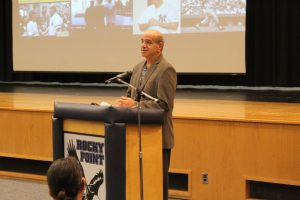
Guest speaker ESU officer Owen McCaffrey reflected on what it meant to be an American, and how helpful people were to each other during that tragic time.
“Everyone was an American citizen,” McCaffrey said. “It didn’t matter what you looked like, the color of your skin or how you were dressed — everyone was working together because we were all American citizens.”
Suffolk County Acting Police Commissioner, Stuart Cameron recalled what it was like for the SCPD after the attacks had taken place, noting that the New York City Police Department even reached out to them for help.
The SCPD sent out hundreds of officers to Ground Zero.
“The most difficult aspect was that my phone was ringing off the hook with members of our department volunteering to go help their brother officers in New York City,” Cameron said.
Unfortunately, many of the officers who volunteered to help later passed due to medical complications, mostly being cancer related.
“9/11 is not one day,” Cameron said. “It’s the days, weeks and months after it. You know the saying, ‘it’s the gift that keeps on giving,’ well 9/11 is the event that keeps on taking. It truly has taken away some of our greatest heroes.”
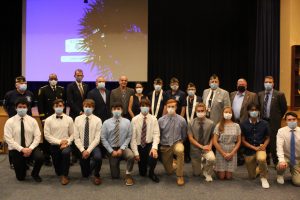
Another guest speaker, Phil Alverez, whose brother, former NYPD detective, Luis Alverez passed from complications of cancer from working on Ground Zero.
Phil said Luis wasn’t interested in people knowing his name, rather, he wanted people to know the message, which was to get victims and first responders assistance for the damaging health effects Ground Zero caused.
“I was fortunate to have Luis around 15 years after the attacks, even though he was dealing with stage four cancer,” he said. “I got to hold him and hug him and tell him that I love him, and at the end of his life, I got to say goodbye to him — 3,000 families that day didn’t.”
Plain Talk: We must never forget 09-11-01
By Fr. Francis Pizzarelli
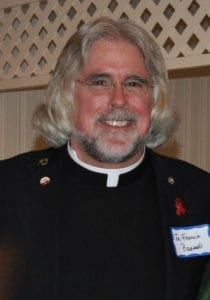
On September 11, 2001, where were you? I remember that day like it was yesterday. I was teaching my Freshman Seminar Class at St. Joseph’s College in Patchogue. It was a beautiful sunny day. Right after that all of our classes were suspended. I celebrated the campus mass that day. We prayed for all the victims, for all the first responders and for our nation.
It was a scary day, but it also brought out the best in all of us. The solidarity that emerged in the days after 9/11 was inspirational. The spontaneous gatherings to honor our first responders, firefighters, and police were heartwarming.
President Bush brought us together as a nation reminding us “we must never forget!” When he addressed the nation that day he made everyone feel better and feel that we were connected to each other.
Much has happened these past 20 years since 9/11. The world has changed and so has our nation. Technology has transformed a whole generation. Unfortunately, it is a double-edged sword. In an instant you can have information about anything you desire that would normally take you days and weeks to gather. It has also become in some circumstances a painful distraction. People are obsessed with their cell phones. Communication skills have become weaker. As a teacher, I have found a growing number of my students have inadequate critical thinking and analytical writing skills.
Recently, I took an informal poll of my college students. 90% of more than 100 students acknowledged being on their cell phone more than being engaged in any other activity. Most of them agreed that cell phone use is out of control.
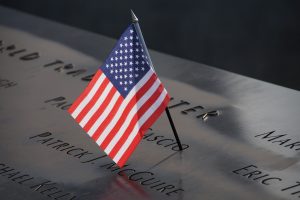
We talked about the need for more human connection and how polarized our nation is. It was amazing to see how many believe that their vote does not matter. We talked about civic engagement, how they are the future leaders of our nation and that they need to become more involved today.
On the 20th anniversary of 9/11, I was profoundly moved by the words of our former President George Bush at the Shanksville National Memorial in Pennsylvania. He reminded the nation of the need for unity and solidarity; that we need to rediscover the same American spirit that brought us together 20 years ago on that horrific day. He also reminded us that home-grown terrorism is as evil as terrorism around the world because it destroys the fabric of our nation by encouraging violence, hate and destruction.
As we remember 9/11 and the thousands that died on that dark day in American history, let us recommit ourselves to social justice and human rights; let us recognize our greatness in our diversity and our respect for the dignity of all people.
Father Francis Pizzarelli, SMM, LCSW-R, ACSW, DCSW, is the director of Hope House Ministries in Port Jefferson.




